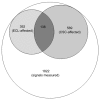E-Cigarette Affects the Metabolome of Primary Normal Human Bronchial Epithelial Cells
- PMID: 26536230
- PMCID: PMC4633226
- DOI: 10.1371/journal.pone.0142053
E-Cigarette Affects the Metabolome of Primary Normal Human Bronchial Epithelial Cells
Abstract
E-cigarettes are widely believed to be safer than conventional cigarettes and have been even suggested as aids for smoking cessation. However, while reasonable with some regards, this judgment is not yet supported by adequate biomedical research data. Since bronchial epithelial cells are the immediate target of inhaled toxicants, we hypothesized that exposure to e-cigarettes may affect the metabolome of human bronchial epithelial cells (HBEC) and that the changes are, at least in part, induced by oxidant-driven mechanisms. Therefore, we evaluated the effect of e-cigarette liquid (ECL) on the metabolome of HBEC and examined the potency of antioxidants to protect the cells. We assessed the changes of the intracellular metabolome upon treatment with ECL in comparison of the effect of cigarette smoke condensate (CSC) with mass spectrometry and principal component analysis on air-liquid interface model of normal HBEC. Thereafter, we evaluated the capability of the novel antioxidant tetrapeptide O-methyl-l-tyrosinyl-γ-l-glutamyl-l-cysteinylglycine (UPF1) to attenuate the effect of ECL. ECL caused a significant shift in the metabolome that gradually gained its maximum by the 5th hour and receded by the 7th hour. A second alteration followed at the 13th hour. Treatment with CSC caused a significant initial shift already by the 1st hour. ECL, but not CSC, significantly increased the concentrations of arginine, histidine, and xanthine. ECL, in parallel with CSC, increased the content of adenosine diphosphate and decreased that of three lipid species from the phosphatidylcholine family. UPF1 partially counteracted the ECL-induced deviations, UPF1's maximum effect occurred at the 5th hour. The data support our hypothesis that ECL profoundly alters the metabolome of HBEC in a manner, which is comparable and partially overlapping with the effect of CSC. Hence, our results do not support the concept of harmlessness of e-cigarettes.
Conflict of interest statement
Figures



References
-
- Zhu SH, Sun JY, Bonnevie E, Cummins SE, Gamst A, Yin L, et al. Four hundred and sixty brands of e-cigarettes and counting: implications for product regulation. Tob Control. 2014;23 Suppl 3:iii3-9. Epub 2014/06/18. doi: tobaccocontrol-2014-051670 [pii] 10.1136/tobaccocontrol-2014-051670 - DOI - PMC - PubMed
-
- Polosa R, Caponnetto P, Morjaria JB, Papale G, Campagna D, Russo C. Effect of an electronic nicotine delivery device (e-Cigarette) on smoking reduction and cessation: a prospective 6-month pilot study. BMC Public Health. 2011;11:786. Epub 2011/10/13. doi: 1471-2458-11-786 [pii] 10.1186/1471-2458-11-786 - DOI - PMC - PubMed
Publication types
MeSH terms
Substances
LinkOut - more resources
Full Text Sources
Other Literature Sources
Medical

